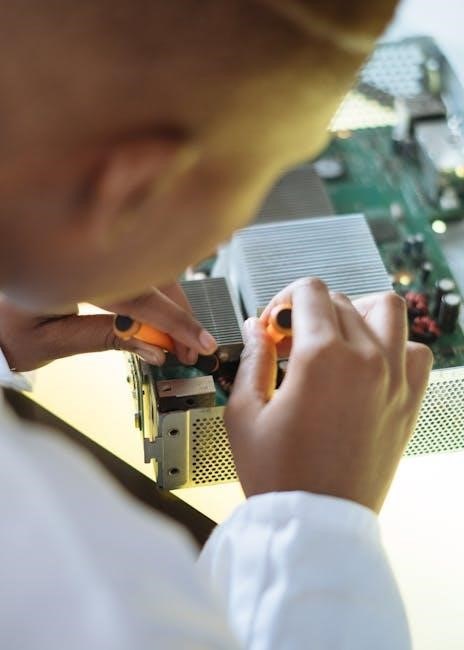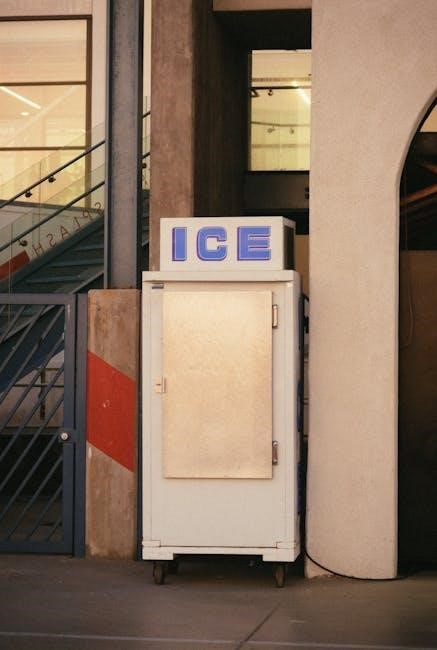Welcome to the KitchenAid Ice Machine Manual, your comprehensive guide to understanding, installing, and maintaining your ice maker. This manual ensures safe and efficient operation, covering key features, installation steps, and troubleshooting tips. Refer to it for model-specific instructions, maintenance schedules, and accessing support resources like the KitchenAid website for downloads and assistance.
1.1 Understanding the Importance of the Manual
The KitchenAid Ice Machine Manual is essential for ensuring safe, efficient, and optimal performance of your appliance. It provides detailed instructions for installation, operation, and maintenance, helping you troubleshoot common issues and extend the lifespan of your ice maker. By following the manual, you can avoid potential errors, ensure proper functionality, and maintain the quality of your appliance. It also serves as a reference for understanding key features and accessing support resources, making it an invaluable guide for both new and experienced users.
1.2 Overview of Key Features and Benefits
The KitchenAid Ice Machine Manual highlights the advanced features of your appliance, including automatic ice making, preset temperature controls, and an ice level sensor. These features ensure consistent ice production, energy efficiency, and convenient operation. The manual also details benefits like easy maintenance, a built-in water filter for clean ice, and a durable design for long-lasting performance. Understanding these features and benefits helps you maximize your appliance’s potential and enjoy high-quality ice with minimal effort. This overview provides a clear foundation for proper usage and care.

Installation and Setup
Installation and setup involve unpacking, positioning, and leveling the ice maker, ensuring proper water supply connection, and following safety guidelines for optimal performance and longevity.
2.1 Unpacking and Preparing the Ice Maker
Begin by carefully unpacking the ice maker, ensuring all components are undamaged. Remove packaging materials and place the unit upright on a stable surface. Allow it to stand for 24 hours before first use to ensure proper functioning. Locate the model number inside the ice maker for future reference. Refer to the KitchenAid manual for specific unpacking instructions tailored to your model.
2.2 Connecting the Water Supply
Connecting the water supply is crucial for your ice maker to function properly. Use a 1/4-inch soft copper tubing or a Whirlpool supply line with a shutoff valve. Ensure the tubing is connected securely to both the ice maker and water supply inlet. Turn off the water supply before starting the connection to prevent leaks. Once connected, check for any leaks by turning the water supply back on. Refer to the KitchenAid manual for specific guidance tailored to your model.
2.3 Leveling the Ice Maker for Proper Function
Proper leveling is essential for your ice maker to function correctly and efficiently. Place a level on top of the unit to ensure it is even from front to back and side to side. Use the adjustable screws at the bottom front to make necessary adjustments. Ensure the unit is level to prevent uneven ice production and operational issues. This step is crucial for maintaining performance. Refer to the KitchenAid manual for detailed instructions.

Operating the Ice Maker
Turn on the ice maker by lowering the wire shutoff arm. The unit will begin the ice-making cycle, circulating water over a freezing evaporator. Monitor operation to ensure proper function and ice production.
3.1 Turning On the Ice Maker
To activate the ice maker, ensure the water supply is turned on and the power is connected. Lower the wire shutoff arm to the “on” position. The unit will begin its cycle, circulating water over the freezing evaporator. Allow time for the first batch of ice to form, typically within a few hours. Monitor the process to ensure proper function. If issues arise, refer to the manual for troubleshooting guidance or adjust settings as needed for optimal performance.
3.2 Understanding the Ice-Making Cycle
The ice-making cycle begins with a rinse process, circulating water over the freezing evaporator. Once complete, water flows into the ice mold, freezing into cubes. The cycle includes filling, freezing, and harvesting ice. Sensors monitor temperature and ice levels, ensuring efficient operation. The ice level sensor in the storage bin prevents overfilling. Regular cycles maintain consistent ice production. If issues arise, refer to the manual for troubleshooting steps to restore functionality and ensure uninterrupted ice supply.
3.4 Monitoring Ice Levels and Adjusting Settings
Monitor ice levels using the sensor in the storage bin to prevent overfilling. The ice maker automatically stops when the bin is full. Adjust settings via the control panel to customize ice production based on needs. Regularly check the water supply and ensure it’s turned on. If ice production is too slow or too fast, tweak the settings accordingly. Maintain proper function by ensuring the ice level sensor is clean and unobstructed. This ensures efficient and consistent ice production, tailored to your household demands.
Maintenance and Care
Regularly clean the ice maker to ensure efficient operation. Check and replace water filters as needed. Inspect the ice level sensor for proper function and clean it if necessary. Schedule routine maintenance to prevent mineral buildup and maintain optimal performance. Refer to the manual for specific cleaning instructions and recommended maintenance schedules to extend the lifespan of your KitchenAid ice machine.
4.1 Cleaning the Ice Maker Regularly
Regular cleaning is essential for maintaining your KitchenAid Ice Maker’s performance; Start by turning off the power and water supply. Remove any ice and drain the water pan. Mix a solution of water and vinegar to clean the interior, paying attention to the water pan and ice storage bin. Scrub gently with a soft brush to remove mineral buildup. Rinse thoroughly and dry to prevent mold growth. Clean the ice level sensor and other visible parts to ensure proper function. Regular cleaning prevents bacteria growth and keeps your ice fresh and odor-free. Always refer to the manual for specific cleaning instructions tailored to your model.
4.2 Replacing Parts and Filters
Regularly replacing parts and filters ensures optimal performance of your KitchenAid Ice Maker. The water filter should be replaced every 6 months or as indicated by reduced ice production. Use genuine KitchenAid filters for compatibility and performance. To replace parts, turn off power and water supply. Access the filter compartment, typically located on the right side, and swap it with a new one. Refer to your manual for specific model instructions. Damaged or worn parts, like O-rings or sensors, should be replaced promptly to prevent leaks or operational issues. Always use certified KitchenAid parts for reliability and longevity.

Troubleshooting Common Issues
Troubleshoot common issues like low ice production or leaks by checking water supply, ensuring proper leveling, and verifying filter condition. Refer to the manual for specific solutions.
5.1 Diagnosing and Solving Ice Production Problems
If your KitchenAid ice maker isn’t producing ice, start by checking the power supply and water connection. Ensure the ice maker is turned on and the water supply valve is open. Low water pressure or a faulty filter may cause reduced ice production. Check the ice level sensor for proper function and ensure the storage bin is not full. If issues persist, refer to the manual for specific troubleshooting steps or contact KitchenAid support for assistance. Regular maintenance, like cleaning or replacing filters, can often resolve production problems.

Accessing and Downloading the Manual
Visit the KitchenAid website to find and download the manual for your specific ice maker model. Enter your model number to access the PDF guide, ensuring proper installation, operation, and maintenance. For assistance, contact KitchenAid support directly through their website or customer service hotline.
6.1 Finding the Right Manual for Your Model
To find the correct manual for your KitchenAid ice maker, visit the official KitchenAid website or trusted platforms like ManualsLib. Enter your ice maker’s model number, located inside the unit or on the product label, to access the specific PDF guide. This ensures you receive accurate instructions tailored to your appliance. For additional support, contact KitchenAid customer service or refer to their online resources for troubleshooting and maintenance tips. Always verify the manual’s compatibility with your model to avoid confusion.
6.2 Using the KitchenAid Website for Support
The KitchenAid website offers extensive support for your ice maker. Visit the Service and Support section to find manuals, troubleshooting guides, and FAQs. Enter your model number to access specific resources, ensuring accurate information for your appliance. The site also provides contact details for customer service and links to authorized dealers. For additional convenience, you can download the KitchenAid CraftApp or explore troubleshooting tips. This platform is your one-stop solution for maintaining and optimizing your ice maker’s performance.
Safety Precautions
Always read the manual before installation and use. Disconnect power before servicing. Use sturdy glass for dispensing ice. Avoid hitting refrigerator doors. Not intended for persons with reduced physical or sensory abilities.
7.1 Important Safety Notes for Installation and Use
Always read the manual before installation and use. Ensure the ice maker is installed by a qualified technician. Disconnect power before servicing. Use a grounded 3-prong outlet to prevent electrical hazards. Keep children away from moving parts. Never hit refrigerator glass doors. Ensure proper ventilation and avoid exposure to extreme temperatures. Use only approved water supply lines and follow local plumbing codes. Regularly inspect for leaks or damage to avoid safety risks.




